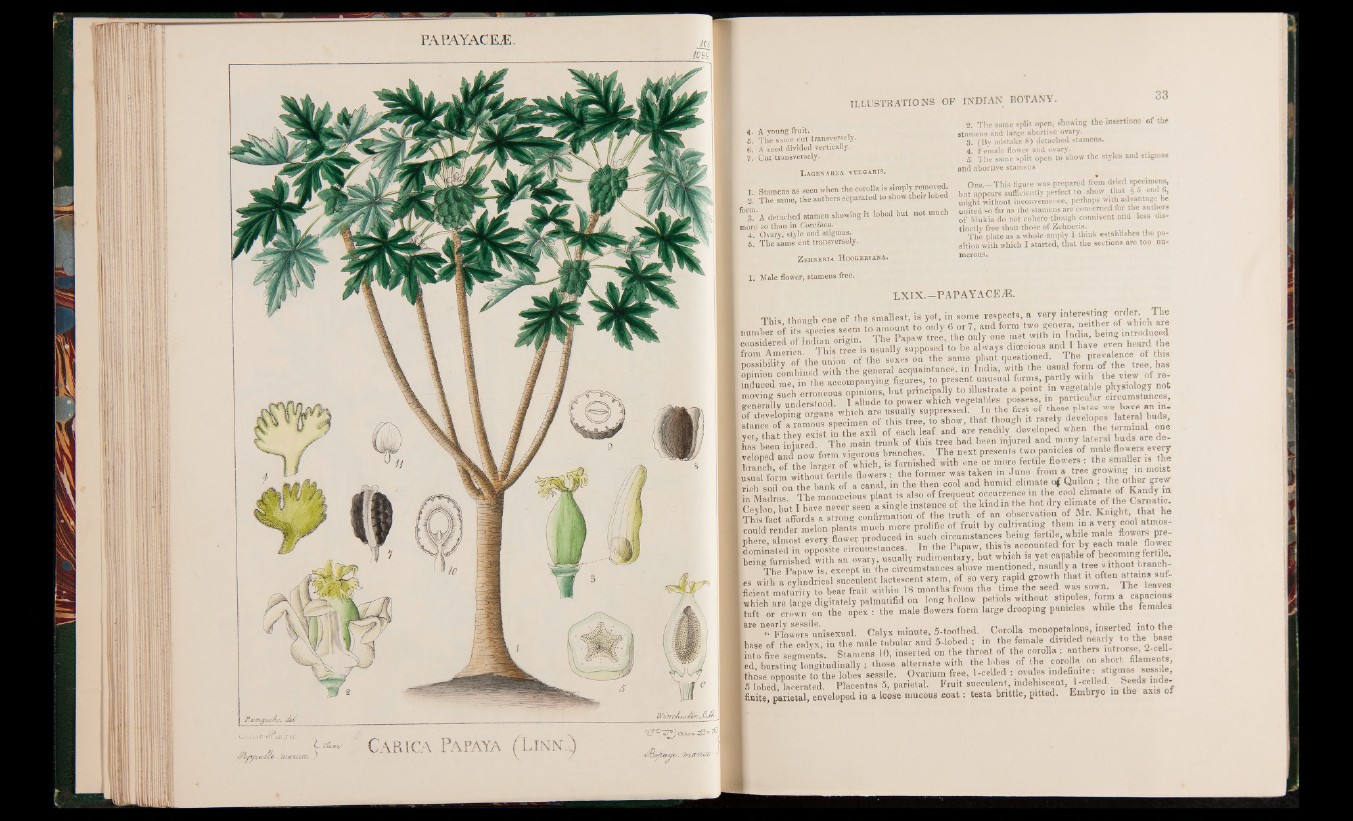
PAPAYACEÆ.
fiu/nÿtoÂj. de/
éJiÿÿzeisd/e'.
C, ZXwti/ C a r i c a P a p a y a ( L i n n ,..
4. A young fruit.
5. The same cut transversely.
• 6. A seed divided vertically.
f, 7. Cut transversely-
Lagenarea vulgaris.
1. Stamens as seen when the corolla is nmplv remove A
| 2. The same, the anthers separated to show their lobea
p 01™ A detached stamen showing it lobed but not much
!•' more so than in Coccinea.
4. Ovary, style and stigmas.
5! The same cut transversely.
Zehneria H ookertana.
1. Male flower, stamens free.
2. The same split open, showing the insertions o f the
stamens and large abortive ovary.
3. (By mistake 8) detached stamens.
4. Female flower and ovary. .
5. The same split open to show the styles and stigmas
and abortive stamens
Obs.—This figure was prepared from dried specimens,
but appears sufficiently perfect to show that § 5 and 6,
might without inconvenience, perhaps with advantage be
united so far as the stamens are concerned for the anthers
of Mukia do not cohere -though connivent and less distinctly
free than those of Zehneria.
The plate as a whole amply I think establishes the position
with which I started, that the sections are too numerous.
LXIX.—PAPAYACEiE.
from. Amen«• 0^ f ^ s e x e s on the same plan? questioned. The prevalence of tins
| possibility of the u" , acclaaintance in India, with the usual form of the tree, has
| Waaaom g ,ing figuqres, to present unusual forms, partly with the view of re-
IM i Mafti iiM
™1™*Tand now'form vigorous branches. The next presents two panicles of male flowers every
IraTch oftheTarTe^of which, is furnished with one or more fertile flowers : the smaller is the
b 1 fn’rm withouffertile flowers : the former was taken in June from a tree growing in moist
rich soi on he bank of a canal, in the then cool and humid climate of Quilon ■ the other grew
tin Madras The monoecious plant is also of frequent occurrence in the cool climate of Kandy m
n 1™ h„t I hav^never seen a single instance of the kind in the hot dry climate of the Carnatic.
I This fact affords a strong confirmation of the truth of an observation of Mr. Knight, that he
Luld render melon planfs much more prolific of fruit by cultivating them in a very cool atmosjphere,
almost j^^e^Pa^^I^hlsis^ccomltedVo^by etmh male flower
| beihgnfurnishedPwith an ovary, usually rudimentary, but which is yet capable of
I T h e Panaw is except in the circumstances above mentioned, usually a tree » ithout branch-
[es with a cylindrical succulent lactescent stem, of so very rapid growth that it often attains suf-
Ificient maturity to bear fruit within 18 months from the time the seed was sown. The leaves
l which are larve digitately palmatifid on long hollow petiols without stipules, form a capacious
Itlift or crown on?the apex : the male flowers form large drooping panicles while the females
iare nearly Calyx hiinrite, 5-toothed. Corolla monopetalous, inserted into the
■base of the calyx, in the male tubular and 5-lohed ; in the female divided nearly to the base
iinto five segments. Stamens 10, inserted on the throat of the corolla : anthers '
le d bursting longitudinally ; those alternate with the lobes of the corolla on short filaments,
■those opposite to the lobes sessile. Ovarium free, 1-celled ovules indefinite’ ■ s t i g ' ’
| 5 lobed! lacerated. Placentas 5, parietal. Fruit succulent, mdehiscent, 1 -ce^d- Y f ' ‘ of
■finite, parietal, enveloped in a loose mucous co a t: testa brittle, pitted. Embryo in the axis of